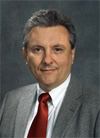
2009 ParCFD Invited Speakers
Dimitris Drikakis, Cranfield University

Dimitris Drikakis is professor of fluid mechanics and computational science, and head of the Aerospace Sciences Department at Cranfield University. In 2008, he was recognized by William Penney Fellowship for his contribution to fluid mechanics and CFD, and their applications to aerospace and defense. Dimitris is Fellow of the Royal Aeronautical Society and Fellow of the Institute of Nanotechnology. His research interests include computational fluid dynamics, fluid mechanics, heat transfer, aerodynamics, computational nanotechnology and materials modeling. Dimitris has co-authored, jointly with William Rider (Sandia National Labs), the book “High-Resolution Methods for Incompressible and Low Speed Flows” Springer 2005. He is an associate editor of the Journal of Fluids Engineering, The Aeronautical Journal, and the Journal of Computational and Theoretical Nanoscience.
Paper Title: "High-Fidelity CFD Simulations of Instabilities, Transition and Turbulence using High-Order Methods and Parallel Computing"
Wagdi Habashi, McGill University

Wagdi Habashi is a professor of mechanical engineering at McGill University in Montreal. He taught at the Stevens Institute of Technology in New Jersey for 2 years and for 25 years at Concordia University in Montreal prior to coming to McGill where he is the NSERC-Bombardier-Bell Helicopter-CAE Industrial Research Chair (IRC) for Multi-disciplinary CFD, currently the only IRC among the Faculty. At McGill, Wagdi has established and is directing its Computational Fluid Dynamics Laboratory. He has also established the CLUMEQ (Consortium Laval-Université du Québec-McGill and Eastern Quebec) Supercomputer Center and was Director from 2000-2007, thrice funded by the Canada Foundation for Innovation and the Quebec Government (60M$ for High Performance Computing).
Paper Title: "A Frontier of Parallel CFD: Real-Time In-Flight Icing Simulation over Complete Aircraft"
Dimitri Mavriplis, University of Wyoming

Dimitri Mavriplis is Professor of Mechanical Engineering at the University of Wyoming. Prior to coming to Wyoming in 2003, Dr. Mavriplis spent 16 years at ICASE, NASA Langley Research center where he developed unstructured mesh discretization and solution techniques for computational aerodynamics, many of which have been widely adopted by NASA and industry. During his career, he has worked on unstructured mesh generation methods and adaptive techniques, agglomeration multigrid solvers, time-implicit methods, and coupled aeroelastic problems. More recently he has been involved in the development of adjoint sensitivity analysis techniques for design-optimization and error estimation problems, as well as the development of high-order discontinuous Galerkin discretizations for aerospace engineering applications. He is a committee member and contributor to the AIAA drag prediction workshop series, and an AIAA Associate Fellow. Most recently, he has been involved in the advocacy of high-performance computing research and development for aerospace engineering disciplines.
Paper Title: "High Performance Computational Engineering: Putting the E back in CSE"
Kazuhiro Nakahashi, Tohoku University

Kazuhiro Nakahashi is a professor within the department of aerospace engineering at Tohoku University in Sendai, Japan. Kazuhiro has developed CFD algorithms including a solution-adaptive grid method using tension-torsion spring analogy, FDM-FEM hybrid method, prismatic grid method, and overset unstructured grid method. During the last decade, he has been working on developing an unstructured grid CFD code named TAS (Tohoku University Aerodynamic Simulation). Currently, the TAS-code is used for aerospace applications at the Japan Aerospace Exploration Agency, industries, and universities throughout Japan. Kazuhiro is a fellow of the Japan Society of Mechanical Engineers and the Japan Society of Fluid Mechanics. He was elected president of the Japan Society for Aeronautical and Space Sciences for FY 2009.
Paper Title: "Building-Cube Method: A Block-Structured Cartesian Grid Approach for Near-Future Peta-Flops Computers"
Horst Simon, Lawrence Berkeley National Laboratory

Horst Simon is Associate Laboratory Director at Lawrence Berkeley National Laboratory for Computing Sciences and the Division Director for the Computational Research Division and Adjunct Professor of Computer Science at the University of California, Berkeley. His research interests are in the development of sparse matrix algorithms, algorithms for large-scale eigenvalue problems, and domain decomposition algorithms. His recursive spectral bisection algorithm is a breakthrough in parallel algorithms. He was also honored with the 1988 Gordon Bell Prize. He has served as a senior manager for Silicon Graphics, the Computer Sciences Corporation, Boeing Computer Services, and has been a member of the faculty at the State University of New York. He is currently a member of the advisory boards of more than five research organizations located throughout the world and is a member of many journal editorial boards and one of four editors of the twice-yearly “TOP500” list of the world’s most powerful computing systems.
Paper Title: "Future Directions in High Performance Computing (HPC) 2009—2018"
Thomas Sterling, Louisiana State University

Dr. Thomas Sterling is a Professor of Computer Science at Louisiana State University, a Faculty Associate at California Institute of Technology, and a Distinguished Visiting Scientist at Oak Ridge National Laboratory. He received his PhD as a Hertz Fellow from MIT in 1984. Dr. Sterling is probably best known as the “father” of Beowulf clusters and for his research on Petaflops computing architecture. He was one of several researchers to receive the Gordon Bell Prize for this work on Beowulf 1997. In 1996, he started the inter-disciplinary HTMT project to conduct a detailed point design study of an innovative Petaflops architecture. He currently leads the MIND memory accelerator architecture project for scalable data-intensive computing and is an investigator on the DOE sponsored Fast-OS Project to develop a new generation of configurable light-weight parallel runtime software system. Thomas is co-author of five books and holds six patents.
Paper Title: "Enabling Exascale through the ParalleX Paradigm"